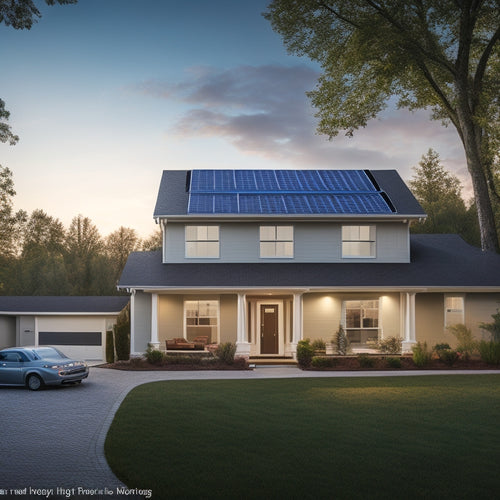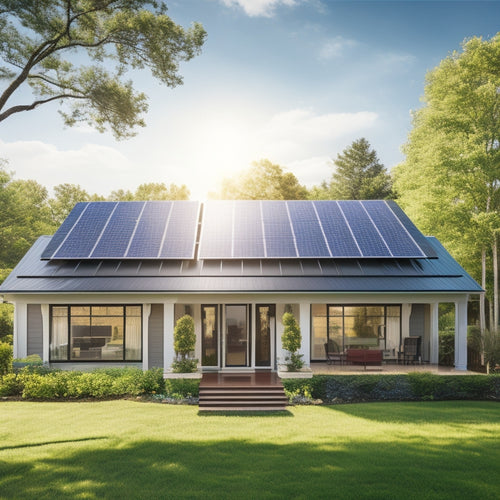
10 Best Energy Saving Audit Tips
Share
You're about to kick-start a thorough energy-saving audit that will help you identify opportunities to reduce your carbon footprint and promote sustainability. Start with a top-down approach, analyzing your energy bills and meter readings to pinpoint major contributors. Next, tackle air leaks and seal gaps, inspect and upgrade your windows, and optimize your water heater. Don't forget to evaluate appliance efficiency ratings, consider smart home devices, and conduct a blower door test to identify hidden air leaks. By following these tips, you'll be well on your way to maximizing energy savings - and there's more to uncover as you take a closer look at each step.
Overview
- Begin with an overall energy usage analysis to identify major contributors and opportunities for reduction.
- Seal air leaks and add insulation to walls, ceilings, and floors to minimize heat transfer and energy loss.
- Upgrade to energy-efficient lighting, windows, and HVAC systems to reduce energy consumption and carbon footprint.
- Optimize water heating efficiency by insulating water heaters, setting temperatures, and considering tankless models.
- Implement smart home technology, such as thermostats and energy monitors, to track and control energy usage in real-time.
Start With a Top-Down Approach
When you initiate an energy-saving audit, it's essential to begin with a thorough understanding of your building's overall energy usage. This involves analyzing your energy consumption patterns to identify areas of inefficiency.
By examining your energy bills and meter readings, you can determine which systems and appliances are the largest contributors to your energy consumption. For instance, embracing independence through solar power systems can greatly reduce your reliance on grid electricity, leading to substantial energy savings.
Additionally, understanding your energy usage patterns can help you identify opportunities to reduce your carbon footprint and promote sustainability. From there, you can develop targeted efficiency strategies to address these areas.
A top-down approach allows you to prioritize your efforts on the most impactful changes, maximizing your energy savings. By tackling the biggest energy wasters first, you'll be able to make the most meaningful reductions in your energy consumption and enjoy the greatest ROI on your audit investment.
Identify Air Leaks and Seal
You'll want to seal gaps and cracks in your home's exterior walls, floors, and ceilings to prevent heated or cooled air from escaping.
Incorporating energy-efficient insulation options like recycled denim or natural wool can also help minimize heat loss.
Next, inspect your doors and windows for air leaks, checking for worn-out weatherstripping, loose frames, and cracked panes.
Seal Gaps and Cracks
Air leaks can account for a significant portion of heat loss in your home, making it essential to identify and seal gaps and cracks in your building envelope.
Proper solar panel installation can also maximize energy production and reduce energy losses. You'll want to assess weatherstripping options for movable joints like doors and operable windows.
For non-movable joints, consider using draft sealing materials like spray foam, caulk, or weatherstripping tape. Seal gaps around electrical outlets, switches, and plumbing fixtures, as well as cracks in walls, floors, and ceilings.
Don't forget to inspect your attic, basement, or crawl space for gaps around vents, ducts, and chimneys.
Inspect Doors and Windows
After sealing gaps and cracks, your attention turns to inspecting doors and windows, which can be significant sources of air leaks.
Check door alignment to make certain it's plumb and level; any misalignment can cause gaps that let air escape. Inspect door sweeps and threshold seals for wear and tear, replacing them if necessary.
Windows require equal attention. Check window sealing around frames, sashes, and panes. Look for signs of wear, cracks, or gaps, and consider applying weatherstripping or caulk to seal any openings.
Don't forget to inspect window locks and latches to make certain they're functioning properly, as they can affect window sealing.
Check Lighting Efficiency
How much energy is being wasted by inefficient lighting in your home or office? Conducting an energy audit can help you identify areas of improvement. Start by evaluating your current lighting setup and looking for opportunities to upgrade to LED alternatives, which use considerably less energy than traditional incandescent bulbs. Consider utilizing natural lighting by placing fixtures near windows or skylights.
| Lighting Control | Energy Savings | Cost |
|---|---|---|
| Dimmer Switches | 4-9% | $20-$50 |
| Light Timers | 2-5% | $10-$30 |
| Outdoor Lighting Sensors | 10-20% | $50-$100 |
| Smart Lighting Systems | 15-30% | $100-$500 |
| Fixture Relocation | 5-10% | $0-$20 |
Insulate Walls and Ceilings
You'll want to inspect your walls and ceilings to reduce heat loss, checking for gaps in insulation that allow warm air to escape.
Next, you'll need to identify areas where additional insulation material can be added to minimize heat transfer.
Reduce Heat Loss
Efficiency takes a significant hit when heat escapes through uninsulated walls and ceilings, resulting in higher energy bills and a less comfortable living space. You can reduce heat loss by identifying and addressing thermal bridges, which are areas where insulation is lacking or inadequate. During an energy audit, inspect your walls and ceilings for gaps, cracks, and openings that allow heat to escape.
| Area | Insulation Type | R-Value |
|---|---|---|
| Walls | Fiberglass batts | R-11 to R-38 |
| Ceilings | Cellulose insulation | R-30 to R-49 |
| Floors | Spray foam insulation | R-30 to R-60 |
Check Insulation Gaps
Through careful inspection, you'll identify gaps in insulation that allow heat to escape, and taking corrective action will greatly reduce heat loss.
Check for air leaks, thermal bridging, and poor insulation materials in your walls, ceilings, attic, and basement. Guarantee proper draft prevention by sealing gaps around electrical outlets, windows, and doors.
Inspect your attic insulation for adequate coverage and consider adding air barriers to prevent moisture intrusion.
In your basement, inspect for gaps and cracks, and seal them to prevent energy loss.
Climate considerations, such as extreme temperatures and humidity, should also influence your insulation strategy.
Add Insulation Material
Frequently, homeowners overlook the importance of adequate insulation in their walls and ceilings, which can lead to significant heat loss and energy waste.
By adding insulation material, you can reap numerous insulation benefits, such as reduced energy consumption, lower utility bills, and a more comfortable living space.
When selecting an insulation type, consider factors like R-value, moisture resistance, and durability. Popular insulation types include fiberglass batts, cellulose, and spray foam.
Insulate walls and ceilings to prevent heat escape and energy loss. Guarantee proper installation to maximize the effectiveness of the insulation material.
Upgrade to Energy-Efficient Windows
Your old windows might be letting heat escape, driving up your energy bills and reducing your home's comfort level. Upgrading to energy-efficient windows can make a significant difference.
Look for windows made with energy-efficient materials, such as low-E glass, double- or triple-paned glass, and vinyl or fiberglass frames. These materials reduce heat transfer and minimize air leaks.
When it comes to window installation, consider hiring a professional to guarantee a proper fit and seal. Proper installation can make a big difference in the overall energy efficiency of your windows.
Inspect and Maintain HVAC Systems
Inspecting and maintaining your heating, ventilation, and air conditioning (HVAC) systems is essential for ideal energy efficiency and extending their lifespan.
You'll want to prioritize regular HVAC maintenance to identify and address potential issues before they escalate into costly repairs.
Consider system upgrades to modern, energy-efficient models, which can greatly reduce your energy consumption.
Don't forget to replace filters regularly, as dirty filters can increase energy bills and reduce system performance.
Additionally, investigate energy recovery opportunities, such as heat recovery ventilation systems, to maximize your HVAC system's potential.
Optimize Your Water Heater
As you've optimized your HVAC system, it's time to focus on another significant energy consumer in your home: the water heater.
Regular water heater maintenance is essential to reduce energy consumption. Check the temperature and pressure relief valve to verify it's functioning correctly. Insulate the heater to minimize heat loss, and consider installing a tankless water heater for increased efficiency.
Additionally, turn down the thermostat to 120°F (49°C) to save energy and prevent scalding. These energy saving tips will help reduce your water heating costs.
Evaluate Appliance Efficiency Ratings
When shopping for new appliances, you'll want to check the Energy Star ratings to guarantee you're getting an energy-efficient model.
Compare the EnergyGuide labels to see which appliances use the least amount of energy, and identify inefficient models that should be replaced.
Check Energy Star Ratings
You're likely familiar with the Energy Star label that appears on many appliances, but do you know what it really means? Energy Star is a program run by the U.S. Environmental Protection Agency that helps consumers identify energy-efficient products. When shopping for new appliances, look for the Energy Star label to guarantee you're getting a product that meets energy consumption standards set by the EPA.
| Appliance | Energy Star Requirements | Benefits |
|---|---|---|
| Refrigerators | 15%-20% more efficient than federal standards | Reduced energy consumption, lower utility bills |
| Washing Machines | 20%-30% more efficient than federal standards | Water and energy savings, reduced laundry time |
| Air Conditioners | 10%-20% more efficient than federal standards | Improved cooling performance, reduced energy consumption |
Compare EnergyGuide Labels
Beyond the Energy Star label, another important resource for evaluating appliance efficiency is the EnergyGuide label.
You'll find this label on most appliances, and it provides an energy label comparison that helps you make informed purchasing decisions. The EnergyGuide label displays the appliance's efficiency rating analysis, including its energy consumption and operating cost estimates.
When comparing labels, look for the ENERGY STAR certified mark, which indicates the appliance meets energy efficiency standards.
Analyze the labels to determine which appliance is the most energy-efficient. Consider factors like the appliance's energy consumption per year, its energy cost per year, and its energy efficiency ratio.
Identify Inefficient Models
During your energy-saving audit, pinpointing inefficient models is essential to optimizing your energy consumption.
You'll want to identify appliances with outdated technology that are guzzling energy. Check the EnergyGuide labels and look for energy efficient appliances with high ratings. Compare the ratings to the national average and to similar models.
If your appliances are lacking, consider replacing them with more efficient ones. This is especially important for appliances with high usage rates, such as refrigerators and air conditioners.
Consider Smart Home Devices
Smart home devices can greatly impact your energy consumption by providing real-time data on your energy usage and automating various energy-intensive tasks.
You can install smart thermostats to optimize your comfort settings, energy monitors to track your energy reports, and automated lighting to adjust brightness based on natural light availability.
Voice assistants can be integrated to control these devices remotely, ensuring you're in charge of your home's energy usage even when you're not there.
Additionally, consider integrating your appliances to optimize their performance and schedule their usage.
With remote management, you can receive notifications when devices aren't in use, allowing you to make adjustments and reduce standby power consumption.
Conduct a Blower Door Test
As you investigate deeper into your energy-saving audit, it is essential to identify areas where air leaks are occurring, and a blower door test is an effective way to do so. This test helps you detect air leaks by creating a pressure difference between the inside and outside of your home. A fan is mounted in an exterior door frame, and when it's turned on, it pulls air out of your home, lowering the air pressure inside. This allows you to identify areas where air is entering or escaping.
| Test Condition | Air Pressure | Results |
|---|---|---|
| Normal | 0 Pa | Baseline reading |
| Depressurized | -50 Pa | Air leaks are more apparent |
| Pressurized | 50 Pa | Air leaks are less apparent |
| With HVAC | Varies | Identifies leaks in HVAC system |
Frequently Asked Questions
How Often Should I Conduct an Energy Audit for My Home?
You should conduct an energy audit for your home every 2-3 years to identify areas of high energy consumption and update your audit checklist, ensuring you're optimizing your energy efficiency and reducing waste.
Can I Perform an Energy Audit on My Own or Hire a Professional?
You can opt for a DIY energy audit, using online resources and tools, but hiring professional services provides a more thorough assessment, leveraging their knowledge to identify and prioritize energy-saving opportunities customized to your home's unique needs.
What Is the Average Cost of an Energy-Efficient Home Renovation?
As you commence on an expedition to change your humble abode into an eco-friendly haven, you'll uncover the average cost of an energy-efficient home renovation can range from $30,000 to $100,000, depending on the use of sustainable energy efficient materials and renovation financing options that suit your freedom-loving budget.
Do Energy-Efficient Upgrades Increase My Home's Resale Value?
You'll be pleased to know that energy-efficient upgrades considerably enhance your home's resale value, as they appeal to environmentally conscious buyers and offer tangible energy efficiency benefits, ultimately increasing your home's marketability and sale price.
Are Energy Audits Only Necessary for Old or Inefficient Homes?
You may think energy audits are only for old or inefficient homes, but that's a common misconception. In reality, an energy audit reveals benefits for any home, regardless of age or efficiency, by identifying areas for improvement and potential cost savings.
Ready to Buy
You've completed the energy-saving audit and are now armed with a list of areas for improvement. Don't be overwhelmed by the potential costs - remember, every dollar invested in energy efficiency can save you up to $4 in the long run. By tackling these tasks, you'll not only reduce your carbon footprint but also enjoy lower utility bills and a more comfortable living space.
Related Posts
-

Is This the Future of Alternative Energy Systems
Yes, alternative energy systems are shaping the future of energy. Innovations in solar and wind technologies are driv...
-

Cost of Solar With Battery Backup
You're investing in a solar panel system with battery backup to guarantee reliable power during outages. The cost of ...
-

Home Solar Installation Cost
You're considering installing solar panels on your home, and the upfront cost is likely the biggest hurdle standing i...


